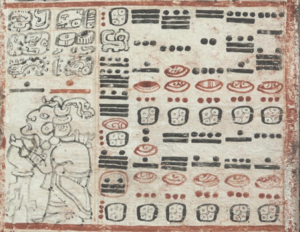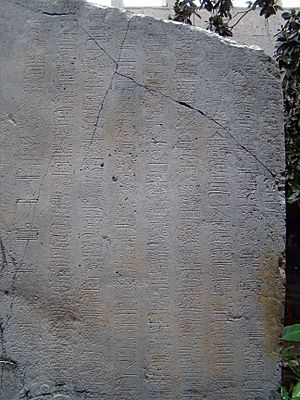Maya numerals facts for kids
The Mayan numeral system was how the ancient Maya civilization wrote down numbers and calendar dates. It was a special way of counting based on the number 20, much like our system is based on 10. This system used only three main symbols:
- A dot (•) for the number one.
- A bar (—) for the number five.
- A shell-like shape ( ) for zero.
With these three symbols, the Maya could write any number up to 19. For example, the number thirteen was shown as three dots above two bars. (Each bar is 5, so 5 + 5 = 10. Then add 3 dots, so 10 + 3 = 13).
Numbers larger than 19 were written by stacking symbols vertically. Each level represented a higher power of 20. This is similar to how we use ones, tens, hundreds, and thousands places in our number system.
For example, to write the number 33:
- The bottom level would show 13 (three dots and two bars).
- The level above it would show 1 (one dot).
This means (1 x 20) + 13 = 33.
| (1×20) | + | 13 | = | 33 |
When numbers reached 20x20 (which is 400), another row was added. For example, the number 429 would be written with three levels:
- The bottom level would show 9 (four dots and one bar).
- The middle level would show 1 (one dot), representing 1 x 20.
- The top level would show 1 (one dot), representing 1 x 400.
So, (1 x 400) + (1 x 20) + 9 = 429.
| (1×202) | + | (1×201) | + | 9 | = | 429 |
Sometimes, instead of dots and bars, the Maya used special face-like pictures called glyphs for numbers. These face glyphs were rare and usually found on very detailed stone carvings.
The Maya had different ways to draw the zero symbol, especially in important books like the Dresden Codex. These shell-like shapes for zero might have meant "circular" or "complete," showing that a number position was full.
Contents
Adding and Subtracting Numbers
Adding and subtracting numbers using Mayan numerals is quite simple, especially for numbers under 20.
How to Add
To add, you combine the symbols at each level.
If you end up with five or more dots, you remove five dots and replace them with one bar. If you get four or more bars, you remove four bars and add one dot to the next level up. This shows that one bar is equal to five dots.
How to Subtract
To subtract, you remove the symbols of the smaller number from the larger number at each level.
If you don't have enough dots at a certain level to subtract, you can change one bar into five dots. If you don't have enough bars, you can remove one dot from the level above and add four bars to the level you are working on.
Maya Calendar and Numbers
The "Long Count" part of the Maya calendar used a slightly different way of counting. In the second position (from the bottom), they only used numbers up to 17, not 19. Also, the third position didn't represent 20x20 (400) as you might expect. Instead, it represented 18x20 (360). This was probably because 360 is close to the number of days in a year. (The Maya knew the solar year was about 365.2422 days).
After the third position, the numbers went back to using all twenty digits, with place values like 18x20x20 (7,200) and so on. This special calendar system is the main way we see large numbers written in the Maya system.
Where Did It Come From?
Many ancient cultures in Mesoamerica (like the Olmec) used similar number systems based on twenty. They also used the idea of zero as a placeholder, which was important for the Long Count calendar. The earliest known Long Count dates are from around 36 BC.
Some of the oldest Long Count dates were found in the area where the Olmec people lived. This made some people think the Olmec invented the system and the idea of zero. However, the Olmec civilization ended hundreds of years before these dates, so it's more likely that another group developed it after the Olmec.
Images for kids
See also
 In Spanish: Numeración maya para niños
In Spanish: Numeración maya para niños
- Kaktovik numerals, a similar number system from another culture, created more recently.






